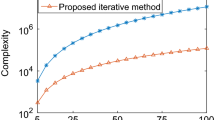Abstract
During blind separation, noise exists and effects the work. This paper presents novel techniques for blind separation of instantaneously mixed digital sources in noise circumstance, which is based on characteristics of digital signals. The blind separation and denoising algorithms include two steps. First, one of adaptive blind separation algorithms in existence is used to separate sources, but there still exists noise in the separating signals, and then, the second step is adopted to denoise according to the characteristics of digital signals. In the last simulations, the good performance is illustrated and the algorithm is very excellent.
The work is supported by the National Natural Science Foundation of China for Excellent Youth (Grant 60325310), the Guangdong Province Science Foundation for Program of Research Team (grant 04205783), the National Natural Science Foundation of China (Grant 60505005), the Natural Science Fund of Guangdong Province, China (Grant 05103553), the Specialized Prophasic Basic Research Projects of Ministry of Science and Technology, China (Grant 2005CCA04100).
Preview
Unable to display preview. Download preview PDF.
Similar content being viewed by others
References
Hyvarinen, A., Oja, E.: Independent component analysis: Algorithms and applications. Neural Networks 38(13), 411–430 (2000)
Stone, J.: Blind source separation using temporal predictability. Neural Computation (13), 1559–1574 (2001)
Bofill, Z.M.: Underdetermined source separation using sparse representations. Signal processing 81, 2353–2362 (2001)
Xie, S.L., He, Z.S., Fu, Y.L.: A note on stone’s conjecture of blind signal separation. Neural Computation 17(2), 321–330 (2005)
Zhang, J.L., Xie, S.L., He, Z.S.: Separability theory for blind signal separation. Zidonghua Xuebao/Acta. Automatica Sinica 30(3), 337–344 (2004)
Amari, S., Cichocki, A., Yang, H.: A new learning algorithm for blind signal separation. In: Touretzky, D.S., Hasselmo, M.E. (eds.) Advances in Neural Information Processing Systems, vol. 8, pp. 757–763 (1996)
Bell, A.J., Sejnowski, T.J.: An information-maximization approach to blind separation and blind deconvolution. Neural Computation 7(6), 1129–1159 (1995)
Pham, D.T.: Mutual information approach to blind separation of stationary sources. IEEE Trans. Inform. Theory 48, 1–12 (2002)
Zhang, J.L., Xie, S.L., He, Z.S.: Separability theory for blind signal separation. Zidonghua Xuebao/Acta. Automatica Sinica 30(3), 337–344 (2004)
Anand, K., Reddy, V.U.: Maximum likelihood estimation of constellation vectors for blind separation of co-Channel BPSK signals and its performance analysis. IEEE Trans. Signal Processing 45(7), 1736–1741 (1997)
Pajunen, P.: Blind separation of binary sources with less sensors than sources. In: Processings of 1997 International Conference on neural Networks, Houston, Texas, USA (1997)
Belouchrani, A., Cichocki, A.: An adaptive algorithm for the separation of finite alphabet signals. In: Proceedings of workshop on signal processing and applications 2000, Brisbane, Australia (December 2000)
Li, Y., Cichocki, A., Zhang, L.: Blind separation and extraction of binary sources. Communication and Computer Sciences E86-A(3), 580–590 (2003)
Li, Y., Zhang, L.: New algorithm for blind enhancement of digital images. Control Theory and Applications 20(4), 525–528 (2003)
Author information
Authors and Affiliations
Editor information
Editors and Affiliations
Rights and permissions
Copyright information
© 2006 Springer-Verlag Berlin Heidelberg
About this paper
Cite this paper
Tan, B., Li, X. (2006). Blind Separation of Digital Signal Sources in Noise Circumstance. In: King, I., Wang, J., Chan, LW., Wang, D. (eds) Neural Information Processing. ICONIP 2006. Lecture Notes in Computer Science, vol 4232. Springer, Berlin, Heidelberg. https://doi.org/10.1007/11893028_125
Download citation
DOI: https://doi.org/10.1007/11893028_125
Publisher Name: Springer, Berlin, Heidelberg
Print ISBN: 978-3-540-46479-2
Online ISBN: 978-3-540-46480-8
eBook Packages: Computer ScienceComputer Science (R0)




